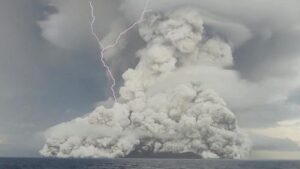Tongas Volcanic Eruption Could Cause Unusual Weather For the Rest of the Decade, New Study Shows
{Tongas Volcanic Eruption – Lets hope the study is correct, but its not an excuse to do nothing – Earth and Leaf Editorial}
{extract below}

Tongas volcanic eruption could cause unusual weather for the rest of the decade, new study shows
Hunga Tonga-Hunga Ha’apai (Hunga Tonga for short) erupted on January 15 2022 in the Pacific Kingdom of Tonga. It created a tsunami which triggered warnings across the entire Pacific basin, and sent sound waves around the globe multiple times.
A new study published in the Journal of Climate explores the climate impacts of this eruption.
Our findings show the volcano can explain last year’s extraordinarily large ozone hole, as well as the much wetter than expected summer of 2024.
The eruption could have lingering effects on our winter weather for years to come.
A cooling smoke cloud – Tongas Volcanic Eruption
Usually, the smoke of a volcano – and in particular the sulphur dioxide contained inside the smoke cloud – ultimately leads to a cooling of Earth’s surface for a short period.
This is because the sulphur dioxide transforms into sulphate aerosols, which send sunlight back into space before it reaches the surface. This shading effect means the surface cools down for a while, until the sulphate falls back down to the surface or gets rained out.
This is not what happened for Hunga Tonga.
Because it was an underwater volcano, Hunga Tonga produced little smoke, but a lot of water vapour: 100–150 million tonnes, or the equivalent of 60,000 Olympic swimming pools. The enormous heat of the eruption transformed huge amounts of sea water into steam, which then shot high into the atmosphere with the force of the eruption.
Today’s link to our pages or posts . . .